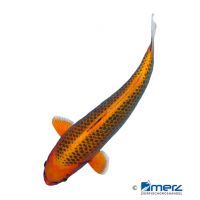Hikari-Muji Koi (Cyprinus carpio carpio)
| Hikari-Muji Koi Cyprinus carpio carpio | |
|---|---|
| Name | Hikari-Muji Koi |
| Name Lat. | Cyprinus carpio carpio |
| Family | Carps |
| Family lat. | Cyprinidae |
| Order | Carps |
| Order lat. | Cypriniformes |
| Origin | Asia (breeding variety) |
| Habitat | Ponds |
| Diet | Omnivore |
| pH | 5.0-8.0 |
| Behavior | Peaceful |
| Keeping | Group |
| Care Level | Moderate |
| Reproduction | Egg scatterer |
| Breeding | Moderately difficult |
| Life Span | 30-50 years |
| Protection | No |
| Metric Units | |
| Size | 20-80 cm |
| Temperature | 4-28 °C |
| Hardness | 10-15 °dH |
| Aquarium | Ponds |
| US Units | |
| Size | 8"-31" |
| Temperature | 39-82 °F |
| Hardness | 178-267 ppm |
| Aquarium | Ponds |
Distribution and habitat
Hikari muji are solid color and metallic shiny koi. Koi is the abbreviation of Nishikigoi and means "brocade carp". Colored carps were bred in China as early as the 11th century. Presumably, the first color variants were bred out of these at the beginning of the 19th century in Japan. At present, there are already 16 main variants with over 100 sub-variants
Maintenance
For husbandry requires a suitably large pond.
The pond should be furnished with pond, floating and oxygenating underwater plants (water milfoil, water plant, hornwort, etc.), large river pebbles and a substrate of round-grained gravel and sand and offer plenty of free swimming space.
No ammonia, ammonium or nitrite should be detectable in the water, and the nitrate level should not exceed 100 mg/l. To ensure the water quality and oxygen content, a filter adapted to the water volume should not be missing.
Diet
The food supply consists mainly of commercially available special dry food for koi with medium protein content (flakes, sticks, granules). In addition, vegetable food such as aquatic plants (e.g. Rizzia flutians), scalded leaves (e.g. dandelion, lettuce, cabbage), cooked rice, etc. or dry food with a particularly high vegetable content (spirulina) can be offered, as well as animal food such as daphnia, mosquito larvae, tubifex, earthworms, snails, mussels, etc. or alternatively a frozen special food mix for koi
Only feed as much as will be eaten in a few minutes. Regular and varied feeding promotes health and increases resistance.
Behaviour and compatibility
They are calm, peaceful and sociable fish that do not show any aggressive or incompatible behavior. At least 5, but preferably more Koi should be kept together
Basically, only compatible fish species with similar demands on water quality and water temperature may be socialized.
Reproduction and breeding
The sexes are difficult to distinguish, males are slightly more slender and have a faint spawning rash at mating time.
Between May and June, at a water temperature of at least 15 °C, females spawn in the shallow shore zone, where the eggs adhere to plants. After 5 days, the larvae hatch and attach to aquatic plants for another 3 days before coming to the water surface to fill their swim bladder with air. Life expectancy can be up to 60 years.
Important
The Hikari-Muji Koi are particularly shiny and have no pattern. To the best known group belong the gold shining Ogon (e.g. Yamabuki, Hi Ogon). Other subspecies are e.g. the golden shining Kin Matsuba (picture) and the silver shining Gin Matsuba. Koi differ mainly in coloration, but also in special scale characteristics. New species are being bred all the time
At temperatures below 20 °C vegetarian feed should predominate, above animal feed.
If Koi are hibernated in the pond, sufficient depth and oxygen supply (filter, oxygen dispenser, ice free holder) should be provided. At temperatures below 10 °C the metabolism slows down and feeding must be stopped. If the temperature drops further, they burrow into the mud and go into hibernation. In the spring, as temperatures rise, feeding can slowly be resumed. Feeding may also be necessary during prolonged warm periods in winter
The well-being of the fish should be monitored regularly. A regular partial water change, according to the pond size is recommended, even if the pollutant load has not yet reached the upper limit. Sudden changes in water quality should be avoided. Newly introduced fish must be accustomed slowly to the water in the pond.
Further literature can be found in your pet store.
References
Text: petdata; Image: Merz Zierfischgroßhandel
Source: BMELV (1998): Tierschutzgutachten - Haltung von Zierfischen (Süßwasser); TEICHFISCHER (2005): Koi in den schönsten Wassergärten, Dähne Verlag; ENGELMANN (2005): Zootierhaltung - Tiere in menschlicher Obhut: Fische, Harri Deutsch Verlag
- Gemäß § 21 Abs. 5 Tierschutzgesetz idgF
